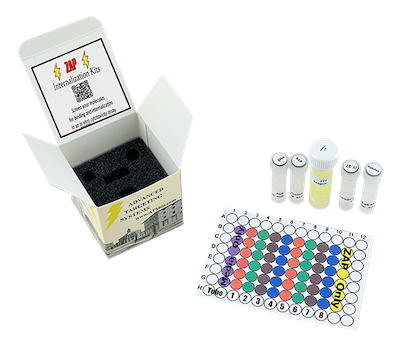Fab-ZAP uses your primary mouse monoclonal IgG antibody to target and eliminate cells that recognize your primary antibody. Fab-ZAP is made with a monovalent secondary antibody eliminating the possibility of cap formation, while preserving all the qualities that make an effective in vitro diagnostic tool. The antibodies used are affinity-purified polyclonal antibodies against both the heavy and light chain of mouse IgG. The antibody used in this product will cross-react across immunoglobulin classes and subclasses of the same species as they share the same light chain (either kappa or lambda). It also has an improved EC50 when directly compared to Mab-ZAP in a cytotoxicity assay.
Fab-ZAP mouse is a chemical conjugate of goat anti-mouse monovalent antibody and the ribosome-inactivating protein, saporin. It uses your mouse primary antibody to target and eliminate cells. This secondary conjugate is used to evaluate the potential of a primary antibody to internalize.
Fab-ZAP mouse is available individually (Cat. #IT-48) or as a kit (Cat. #KIT-48) which includes Fab-ZAP mouse, Saporin (Cat. #PR-01), Fab IgG-SAP (Cat. #IT-67) and reagents for developing a cytotoxicity assay.
Other ZAP Conjugates:
Need another ZAP Conjugate for your target? Check here for other species & targets including in vivo and in vitro options.
keywords: antibody, efficacy, immunotoxin, screening, internalization, saporin, Fab-ZAP, monovalent antibody, secondary conjugate, primary antibody, goat anti-mouse monovalent antibody
Streptavidin-saporin: Converting biotinylated materials into targeted toxins
Ancheta LR, Shramm PA, Bouajram R, Higgins D, Lappi DA (2023) Streptavidin-saporin: Converting biotinylated materials into targeted toxins. Toxins 15(3):181. doi: 10.3390/toxins15030181 PMID: 36977072
Summary: This manuscript describes the myriad of ways Streptavidin-ZAP is used and how this technology supports the scientific process of ‘Molecular Surgery’ and progress in research and drug development. Insights from publications and research performed using Streptavidin-ZAP and its impact on academia and industry for research and drug development are presented.
Related Products: Streptavidin-ZAP (Cat. #IT-27)
Read the full article.
Evaluate Potential Targeting Molecules.
Kohls M (2006) Evaluate Potential Targeting Molecules. Nature Methods
Summary: Targeted toxins -- targeting agents conjugated to saporin -- are widely used to eliminate specific cell populations both in vitro and in vivo. For these molecules to be effective, it is vital that the targeting component of the conjugate specifically binds the cells of interest. A secondary conjugate, Streptavidin-ZAP, has been created by attaching the toxin saporin to streptavidin. The user can combine primary biotinylated material with Streptavidin-ZAP to quickly and economically screen potential targeting molecules for internalization and specificity. Once the appropriate targeting molecule is identified, a direct conjugation with saporin can be performed.
Related Products: Streptavidin-ZAP (Cat. #IT-27)
Read the article.
Saporin as a commercial reagent: its uses and unexpected impacts in the biological sciences-tools from the plant kingdom
Ancheta LR, Shramm PA, Bouajram R, Higgins D, Lappi DA (2022) Saporin as a commercial reagent: its uses and unexpected impacts in the biological sciences-tools from the plant kingdom. Toxins (Basel) 14(3):184. doi: 10.3390/toxins14030184 PMID: 35324681
Summary: Saporin is a ribosome-inactivating protein that can cause inhibition of protein synthesis and causes cell death when delivered inside a cell. Development of commercial Saporin results in a technology termed ‘molecular surgery’, with Saporin as the scalpel. Its low toxicity (it has no efficient method of cell entry) and sturdy structure make Saporin a safe and simple molecule for many purposes. The most popular applications use experimental molecules that deliver Saporin via an add-on targeting molecule. These add-ons come in several forms: peptides, protein ligands, antibodies, even DNA fragments that mimic cell-binding ligands. Cells that do not express the targeted cell surface marker will not be affected. This review will highlight some newer efforts and discuss significant and unexpected impacts on science that molecular surgery has yielded over the last almost four decades. There are remarkable changes in fields such as the Neurosciences with models for Alzheimer’s Disease and epilepsy, and game-changing effects in the study of pain and itch. Many other uses are also discussed to record the wide-reaching impact of Saporin in research and drug development.
Read complete article.
browse all references for this product | back to top



Verified User –
I had the pleasure of ordering the FAB-ZAP human and mouse kit from your company a few months ago. The results achieved with this kit have been truly outstanding and I appreciate the quality of your products.